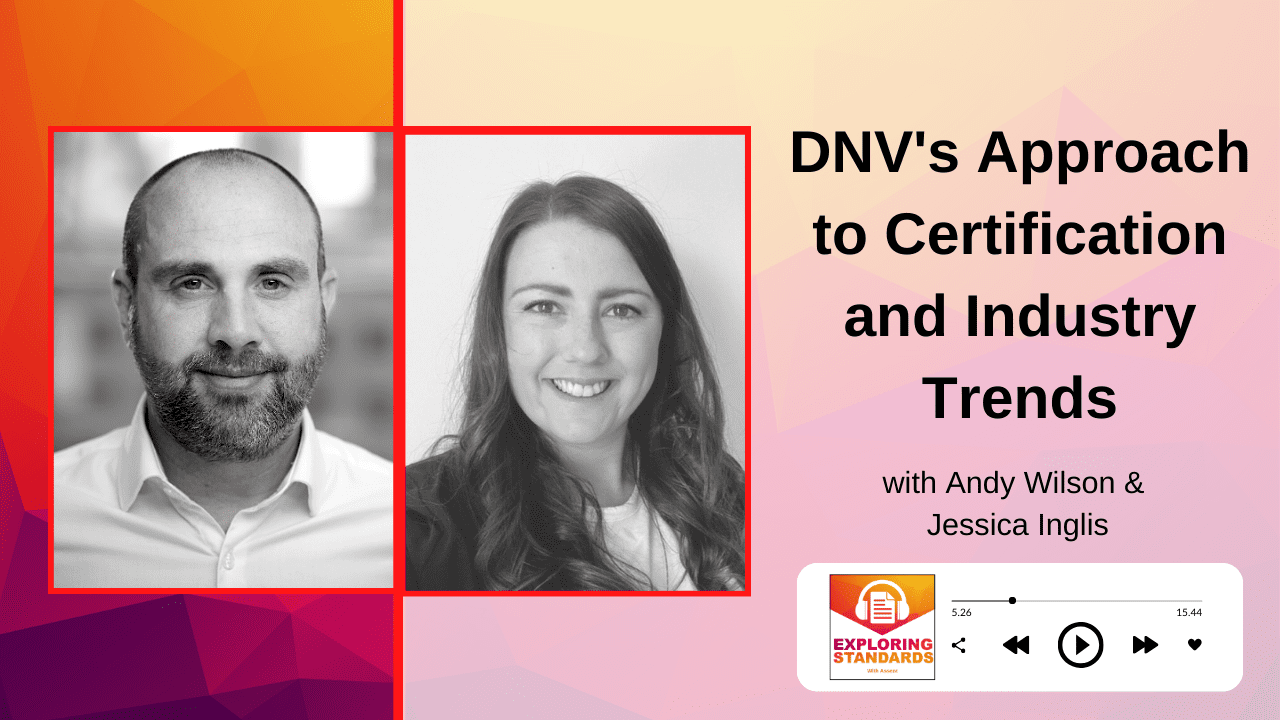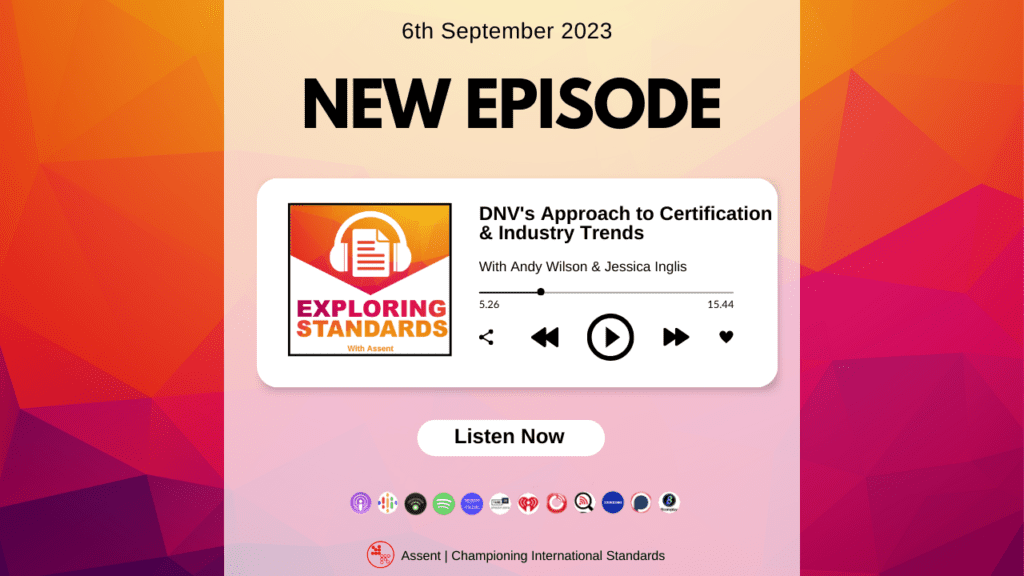As part of Assent’s mission to champion the consultancy industry, Jess from Assent Risk Management has been interviewing experts from all sectors of the consulting profession. In this interview, Jess talks with Andy Wilson from DNV*.
*Assent is an independent consultancy firm and we do not recommend any particular certification body.
How did it feel winning UKConsulting’s Certification Body of the Year Award?
Yeah, I think it’s great. I mean, for us, any sort of external recognition of the hard work that all the team do is great. And we made a big deal of that on LinkedIn, et cetera, so, yeah, really pleased, really proud.
Tell us a bit more about DNV and your role at DNV.
I’ve been with DNV for about eight years, but I’ve previously worked in the assurance industry for over 20 years now. And my roles have ranged from being technical support contracts administrator, a business development manager, and then more recently and within DNV, sales manager and sales director until becoming the country manager three years ago. Now, I’ve seen it all, as it were, over 20 years. Apart from being an auditor, I’ve seen kind of the inner workings of a certification body.
What can I tell you about DNV? I mean, DNV is an International Accredited Certification Body, it’s also a Ship Classification Society headquartered out of Hovik in Norway. We’ve got around 12,000 employees, 350 offices, operating in about 100 countries or so, and we work in multiple industries, but I’d say where we’re well known, or better known is maritime, oil and gas, renewables energy, aerospace, automotive, food and beverage, and healthcare. And that brings me nicely on to the business areas and we have five within DNV.
So there’s Maritime, Energy Systems, SCPA, which stands for Supply Chain Product Assurance, Digital Solutions and finally, Business Assurance. So it’s a large organisation with lots going on. DNV Business Assurance is one of the world’s leading certification bodies. Our offerings now consist solely around management system certification training services to approximately 70,000 customers. So it’s a big operation.
What is DNV’s approach to Certification?
Yeah, so having been in the industry for over 20 years now, I’ve seen various approaches to certification and of course, any UKAS or equivalent accredited certification body is adopting an approach that is acceptable. So the key for us at DNV is how do we differentiate ourselves from the market? And there’s many unique tools that we pride ourselves on in DNV, and that’s what I really wanted to share with everyone today.
There’s just three that I want to highlight, that I feel really add value to an audit, and we include it in every single one of our audit offerings, so you don’t have to pay extra for these items. So the first one is risk based focus areas, which is a bit of a mouthful, but in my opinion, it’s a bit of a game changer when it comes to audits. It’s something that DNV did long before I joined, but immediately upon hearing about it when I joined, I actively kind of sought to promote it wherever I could.
So for each client we certify, we ask them to identify areas of risk within their business, to kind of act as a focus area during the audits. But if they share that perceived risk with us as their certification body, it then allows us to create these heat maps as an output of the audit, if you like, to show the degree of control they have in that area. If it’s green, of course we take it out of focus, but if it’s red or amber, we keep it in there and obviously the client works towards improving the control of that item.
So for me, when I came into DNV and heard about that, I really wanted to shout from the rooftops about that because for me, it’s a really unique selling point, for want of a better word.
The next one I should say is Lumina, which is a software tool that provides kind of instant, if you like, insight into your management system’s performance. So through the tool, you can identify the kind of improvement paths, you can benchmark versus competitors, all anonymously, and you can greater understand risk areas in certain standards or industries, which therefore helps your decision-making process. So we’re able to do this by analysing around two and a half million audit findings. So we’ve got 70,000 customers, as I mentioned earlier, so that really helps us and is the main component behind the benchmarking.
And last but not least is Eadvantage, which is another software tool that is basically a customer friendly view into our CRM tool. So the client can get access to all the information for all of the certified sites, they can get instant access to project status and most importantly, in my opinion, is the ability to track, manage and trace all audit findings and history. It kind of gives you a total overview, if you like, which you can then share insight with others within your business for better management and structured improvement.
Because what we’ve seen in the past with this is where people move on from organisations. They sometimes lose that history of analysis, if you like, of their performance, of their management system. The advantage is the portal, if you like, that captures all of that meaning it’s seamless when you hand over the management of a system to someone else.
What are the most significant trends you are seeing in the industry at the moment?
Yes, a really, really good question. And I suppose post-COVID, there’s been a real shift in where we were. I suppose before COVID some of these things were certainly on our radar, but they’ve fast-tracked, if you like, to the now. Blended audits is the first one, which is a combination of onsite and remote. Prior to COVID, everything was on site, typically. So as we move on from that time, we’ve really embraced this growing expectation of a blend of remote and on-site audits to formulate this audit plan. And we’re credible, and I think that’s a keyword, we encourage our auditors and clients to try and utilise that approach.
Number two is technology, and it kind of runs hand in hand with blended audits to some extent. We’re seeing newer approaches from organisations as they digitalise, so we have to adapt to that. But also we’re going through our own digital journey and so we have to anticipate that things like artificial intelligence plus other remote technologies are going to formulate the future of our industry in the coming years and we need to be, if you like, ahead of the curve on that.
And I’m proud to say DNV are right up there in terms of certification bodies at the front of the technology kind of or digitalisation journey that I’ve seen from others.
And the final one, again, is a post COVID effect, if you like, is consolidation of certification. So what I mean by that is the after effects, if you like, of COVID are still being felt by many businesses. And one of the trends we’re starting to see more often is this consolidation of certification. It’s often driven by an acquisition or a merge of two or more organisations. And these, of course, provide great opportunities for our industry because there’s a bigger organisation to go for.
But I think what’s important and what we’ve seen is it’s really important to support companies on that journey of amalgamating systems. They’re never the same. If you take company one and company two and put them together, very rarely are their management systems aligned. So we have to be patient, flexible, so that we help the organisation through that without jeopardising their certification at that time.
Has the transition to blended audits been beneficial for DNV?
Yeah, absolutely. I mean, it was a must during COVID I mean, we wouldn’t have survived without a remote option. And we have to thank our accrediting bodies for being as flexible at that time to help us continue as a business. And our clients, of course, because they also had to react really quickly to be able to work with us. Our auditors, who had to go from one approach that they’d been used to for all of their lives to suddenly a new approach, huge respect to everyone that went through that process, across all the different elements I mentioned there.
For me, it’s a massive positive from a work life balance for both our clients and our auditors. I think that’s a huge piece that we can take into account. It’s much more pragmatic. There are cases in the past where our auditors would be sat in a room looking at documents. You think, well, that can be done anywhere these days.
But I think credible, as I mentioned earlier, is the key element here. If an audit from an onsite perspective is needed due to health and safety, environmental, and information security implications, then of course, let’s do it right. Let’s go to the site, and let’s make sure that the organisation is adopting the right controls and processes to remain compliant. But in cases where what we’re asking to audit at that time can be delivered remotely, then let’s take advantage of that, because I think it’s a benefit for everyone in the long run.
What advice would you give to organisations going for certification?
Yeah, no, it’s a good question. I had to go back in time a little bit to when I was a BDM and out there talking to many, many clients and I think the message is seek support where applicable. And this is something I used to say to all of my clients back in the day, as it were. So, of course, where an organisation maybe has an employee who has implemented a management system before, from scratch, if you like, and had that system successfully certified, of course they probably have the right credentials to do so again. But in cases where an organisation doesn’t have that expertise, certification body support can only stretch so far. For example, training, we can deliver training, we can do a gap analysis of a management system prior to audit, but we are not allowed to consult and help build a client’s management system. It’s a conflict of interest, as people probably know. It’s like marking your own homework, right? So we can’t do that.
So in the cases where we see a lack of knowledge or resource or there isn’t even a management system ready to audit, I would always urge clients to consider seeking out an organisation to support with the implementation of the management system and also consider keeping that organisation around from a supporting perspective the ongoing maintenance of the system.
Organisations like yourselves are where we would point customers towards, not isolated. We usually give them two or three names and let them make that decision as to who they should move forward with. But for me, in order to support that journey, it’s really important that we understand our prospect or our client at where they are in that journey, look at their competence, look at their capacity and identify which of the options we have available, which is typically consultancy training, gap analysis, which one fits best for them. So either talk to your certification body as early as possible or your desired certification body as early as possible in the process and seek that support where applicable.

Watch on Youtube



